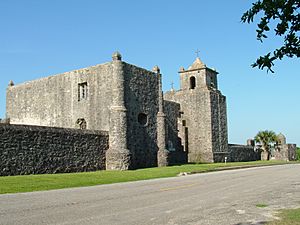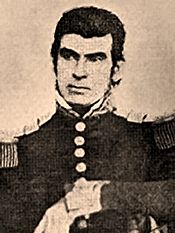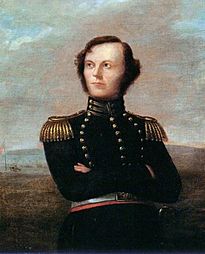Goliad massacre facts for kids
Quick facts for kids Goliad Massacre |
|
|---|---|
| Location | Goliad, Centralist Mexico (now Texas, U.S.) |
| Coordinates | 28°38′51″N 97°22′59″W / 28.6476°N 97.3830°W |
| Date | March 27, 1836 |
| Attack type | Execution by firing squad and wounded being clubbed and knifed to death |
| Deaths | 425–445 Texian Army prisoners of war under the command of Colonel James Fannin who was also killed |
| Perpetrator(s) | Mexican Army, under orders of General and President of the Centralist Republic of Mexico, Antonio Lopez de Santa Anna, the prisoners were not treated as soldiers but were given no quarter as rebels |

The Goliad Massacre was a sad event during the Texas Revolution. It happened on March 27, 1836, in the town of Goliad, Texas. Between 425 and 445 Texian soldiers, who were prisoners of war, were killed by the Mexican Army.
These soldiers were part of the Texian Army from the Republic of Texas. Their commanders, Colonel James Fannin and Lieutenant Colonel William Ward, were also killed. The killings were ordered by General Antonio Lopez de Santa Anna, who was also the President of Mexico. Even though another general, José de Urrea, asked for the Texians to be spared, the massacre still happened.
Contents
What Led to the Goliad Massacre?
Mexico's Plan to Stop Rebels
General Santa Anna found out that some Texas rebels were planning to go to Matamoros. He sent General Urrea to stop them. Urrea traveled north along the Texas coast. He arrived in Matamoros on January 31, 1836. He worked to get help from the people living there.
Meanwhile, General Sam Houston convinced most of the Texian rebels to defend places in Texas instead. Many went to Goliad. On February 12, Colonel Fannin took most of his men to defend Presidio La Bahía at Goliad. He renamed it "Fort Defiance."
First Battles and Captures
On February 16, General Urrea crossed the Rio Grande with his soldiers. He also got about 200 local Tejano volunteers to join him. These were Texans of Mexican heritage.
On February 27, Urrea's soldiers surprised some Texian rebels. This started the Battle of San Patricio. Urrea's forces killed 16 men and captured 24. A few Texians escaped and told Colonel Fannin that all the prisoners had been killed. This news made Fannin decide not to send help to the Battle of the Alamo. Instead, he prepared Fort Defiance at Goliad for a fight.
On March 2, another fight happened at the Battle of Agua Dulce. About 20 Texian men were killed there.
More Texian Forces Captured
On March 6, Santa Anna's army attacked the Alamo and killed all the defenders. On March 14, Colonel William Ward and 200 men were surrounded by Urrea's army near Refugio. Ward and his men tried to escape in a rainstorm. The Mexicans caught some of them, killing 18 and capturing 31.
General Urrea also captured one of Fannin's messengers. This messenger had plans about Fannin waiting at Goliad. Urrea then ordered 30 prisoners to be executed. He believed they were mercenaries, or soldiers hired to fight. He let over 20 other prisoners go, as they were Mexicans or colonists.
The Battle of Coleto and Surrender
On March 19, Urrea's army quickly surrounded about 300 Texian soldiers. This happened on an open field near Goliad. The fight lasted two days and was called the Battle of Coleto. The Texians fought well on the first day. But then, the Mexican army received many more soldiers and powerful cannons.
Because of this difficult situation, Colonel Fannin and most of his men decided to surrender on March 20. They believed they would be set free and sent back to the United States. Instead, they were taken back to the fort at Goliad, which became their prison.
Other Texian groups were also captured and brought to Goliad. This included 18 men from Albert Clinton Horton's company and 75 soldiers from the Nashville Battalion. On March 22, William Ward and his Georgia Battalion (80 men) also surrendered. They were brought to Goliad on March 25.
The Massacre
The Mexican soldiers took the Texians back to Fort Defiance (Presidio La Bahia). The Texian prisoners thought they would be released in a few weeks. General Urrea left Colonel José Nicolás de la Portilla in charge.
Urrea wrote to Santa Anna, asking him to be kind to the Texians. However, Santa Anna had a strict rule passed by the Mexican Congress. This rule said that armed foreigners captured in battle should be treated as pirates and executed. Urrea wrote in his diary that he wanted to avoid these orders if he could.
Santa Anna responded by repeatedly ordering Urrea to follow the law and kill the prisoners. He also sent the same order directly to Colonel Portilla at Goliad. Portilla received this order on March 26. He felt it was his duty to obey, even though he later received another message from Urrea telling him not to.
The next day, March 27, 1836, was Palm Sunday. Colonel Portilla ordered between 425 and 445 Texians to march out of Fort Defiance. They marched in three groups, with Mexican soldiers on both sides. Then, they were shot. Any wounded survivors were also killed.
Forty Texians were too injured to walk. Thirty-nine of them were killed inside the fort. One Texian, Jack Shackelford, was saved by a Mexican officer. Colonel Fannin was the last to be executed.
Almost all the Texian soldiers were killed. Only 28 men survived by pretending to be dead and then escaping. One of them was Herman Ehrenberg, who later wrote about the massacre. Another survivor was William Lockhart Hunter, who was stabbed and hit but still lived. Four men from Shackelford's group also escaped after days of running.
Thanks to a woman named Francita Alavez, known as the "Angel of Goliad," 20 more men were saved. They were kept as doctors, translators, or workers. Also, the 75 soldiers from the Nashville Battalion were spared. They were later marched to Matamoros. The men who were spared were given white armbands. They could walk around freely as long as they wore the armbands. They were told not to take them off, because Mexican soldiers were still looking for any Texians who had escaped.
What Happened After the Massacre?
The Goliad Massacre caused many people in Texas to flee their homes in fear. This event was called the Runaway Scrape.
About a month later, news reached Goliad that Santa Anna had been defeated. He surrendered after the Battle of San Jacinto.
In June 1836, General Thomas J. Rusk found the remains of the massacre victims. He ordered a formal military funeral for them. The remains were buried southeast of the Presidio la Bahia. This spot is now a preserved area called the Fannin Memorial Monument.
The exact location of the gravesite was forgotten for many years. It was rediscovered later when some boys found human bone fragments.
The Goliad Massacre is remembered in a famous poem by Walt Whitman called Song of Myself. In 1939, the Fannin Memorial Monument was built at the gravesite. It has a special art deco sculpture and lists the names of the men who were killed.
See also
 In Spanish: Masacre de Goliad para niños
In Spanish: Masacre de Goliad para niños






